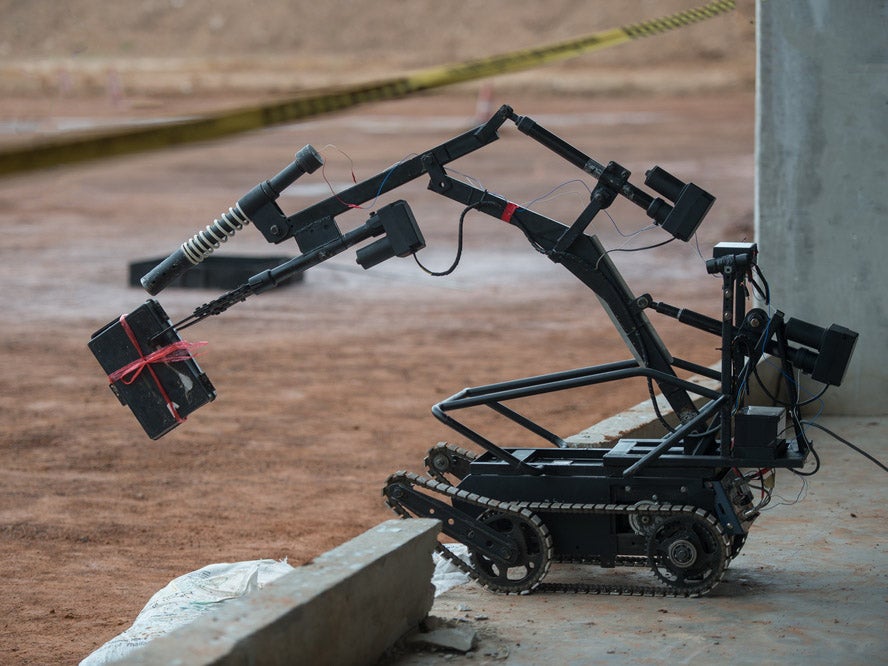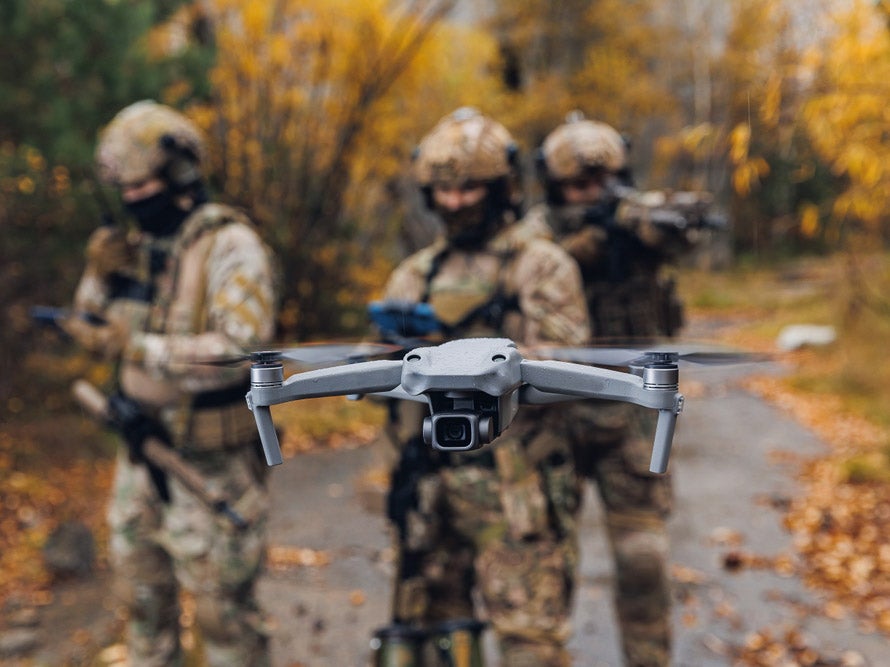
Robotics has significant potential for changing how the defence sector protects troops in the field and improving the efficiency of operations.
Armed forces and defence organisations are steadily pursuing ways to integrate these technologies into practically every area of the value chain, from surveillance to autonomous weapons systems and other combat zone capabilities.
According to GlobalData’s thematic research report, Robotics in Defence, the sector has the second highest exposure to the robotics theme behind the technology industry. The report also forecasts a compound annual growth rate (CAGR) of 28.8% to $568.1bn by 2030 for the robotics industry, with the industrial robot market expected to develop faster than service robots over the next decade.
In the context of rapid digitalisation, rising geopolitical tension, and inflation affecting global military budgets, it has become increasingly important to focus on R&D capabilities to develop robust, dependable robotics and autonomous systems that can assist in military campaigns, providing a tactical advantage and keeping soldiers safe.
Technologies influencing future battlefields
Explosive ordnance disposal (EOD) robots have long been utilised in the defence and security sectors to perform challenging tasks such as the detection, identification, and removal of explosive and incendiary devices. Unmanned aerial vehicles, or drones, are also being extensively used in a range of missions such as intelligence gathering, precision strikes, force protection, surveillance, and reconnaissance. Military drones can provide troops with clearer and closer footage of targets and are cheaper than conventional aircraft in terms of both manufacturing and maintenance.
Automated or remotely controlled technologies can provide real-time information without putting the troops at risk while helping commanders effectively strategise battlefield tactics. As a result, more military forces are looking to use drones to increase their combat and surveillance capacities.
While drone use started in the skies, automated units have since been deployed for land and sea defence operations in the form of unmanned ground vehicles (UGVs), unmanned surface vessels (USVs), and unmanned underwater vehicles (UUVs).
Recent innovations in the fields of UGVs and USVs have shown great potential as force multipliers. These vehicles have larger payloads, better risk tolerance, and higher power outputs than comparable-sized unmanned air or submarine vehicles.
AI and telecommunications advancements allow for wider uses of these technologies in complex applications such as combat, logistics, and manned-unmanned teaming (MUMT). Extensive R&D projects are underway that are exploring disruptive ideas such as exoskeletons, a practical way to reduce soldier injuries during logistics tasks, as well as the development of precision-guided munitions and autonomous systems that can reduce collateral damage in warfare.
At the same time, deploying robotics into established and legacy weapons systems requires components that are precise, reliable, robust, and consume as little power as possible. Military technology is becoming smaller, lighter, and more powerful to improve transportability and stealth operations. Often, sensors, detectors, and circuits deployed in such systems operate under severe conditions, requiring stable and adaptable connector and cable designs that support new robotic devices. Robotic cables must be tensile and torsional stress resistant, as well as versatile enough to adjust to temperature, oil, and chemical resistance requirements.
In designing connectors and interconnect solutions, it is vital to take the environmental conditions they’ll face into consideration. Equally crucial is understanding the data protocols that sensors and electronics will utilise. These protocols not only dictate the number of contacts but also have a cascading effect on the connector’s size. Furthermore, they play a decisive role in shaping the overall construction and functionality of the cable, ensuring optimal performance in diverse settings.

How cables and connectors can advance military robotics
In military robotics, it is essential to have miniaturised cables and connectors capable of functioning in all environmental conditions to ensure seamless operation on the battlefield. Therefore, it is crucial to opt for manufacturers such as Omnetics that provide proven solutions for performing in challenging environments. With more than three decades of experience in connector design and manufacturing, Omnetics specialises in providing reliable and robust miniature and nano-miniature electronic connectors, as well as interconnection systems.
Omnetics offer a range of versatile and configurable connector and cable designs in a “fit-for-application” format, as well as customised options. The brand uses COTS and Standards to work swiftly on customised prototype modules to help finalise fit and function without long delivery delays.
This can be particularly useful for high-reliability applications such as defence robotic tools, where it can be difficult to specify the necessary components because there is no standard connector of the correct size or electrical capabilities to meet every circuit and module demand.
“Our commitment to excellence is reflected in the high performance of our components, even in extreme environments. Our connectors are built to deliver peak performance even under high shock and vibration conditions, a testament to their robust construction and adherence to military-grade specifications,” says an Omnetics spokesperson. “We have pioneered the development of special high-temperature versions of Micro-D connectors and deep space versions that meet NASA’s qualifications for minimal outgassing. Furthermore, we offer mixed-signal designs that are meticulously tailored to each specific application, ensuring seamless integration and functionality in various military robotic tools.
“Our approach is not just about meeting the existing standards but setting new ones, pushing the boundaries of what is possible to facilitate advancements in military robotics. We invite you to explore how Omnetics can serve as a trusted partner in fulfilling your needs in cables and connectors, leveraging our rich heritage of innovation and quality to deliver solutions that are not just fit for purpose, but set a benchmark in excellence.”
The company offers an extensive range of connector designs ranging from nano, and micro sizing to circular versions, as well as connectors designed specifically to meet or exceed IP68 specifications. Components are built to deliver the highest performance through high shock and vibration applications, as well as use in extreme environments. Omnetics also offers special high-temperature versions of Micro-D connectors, deep space versions with Nasa-qualified minimal outgassing, and mixed-signal designs that are tailored to each specific application.
To learn how Omnetics can help serve your needs in cables and connectors, download the whitepaper below.


